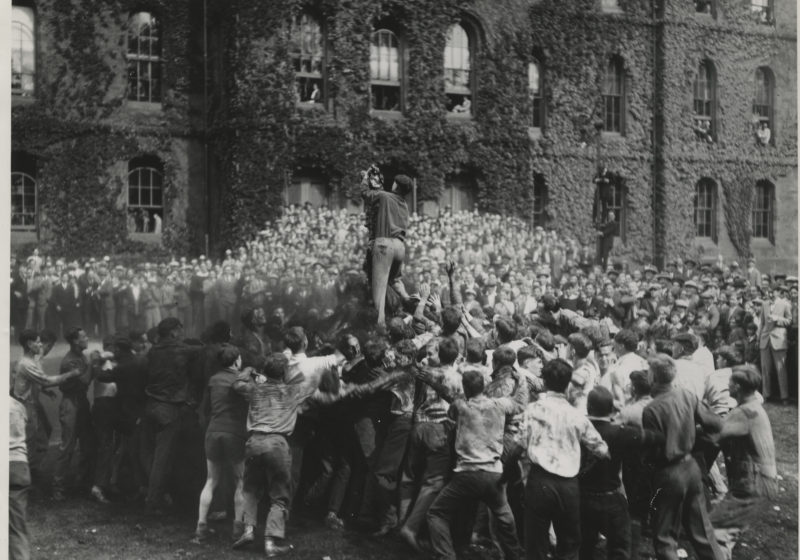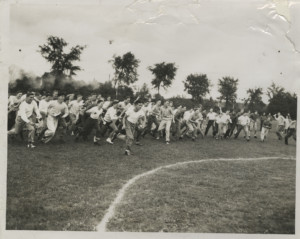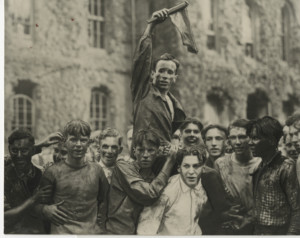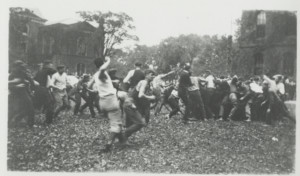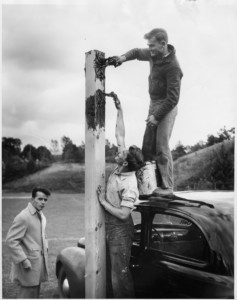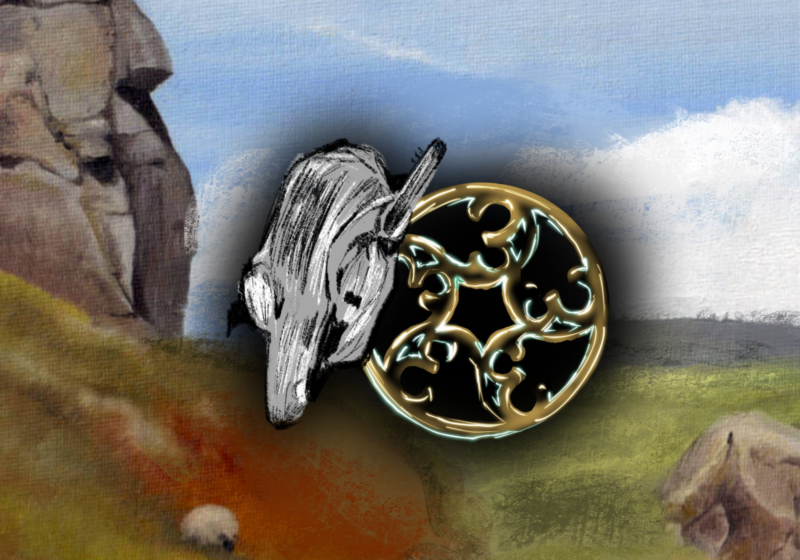A crowd of first-years charge en masse across the field. A flag is nailed atop a pole plastered in black grease. Sophomores cluster around the base, prepared to launch projectiles of varying foulness at the incoming first-year onslaught.
This was the scene that greeted spectators at the annual Flag Rush, held in early fall as a part of the intense interclass rivalries between the new first-year class (“frosh”) and the sophomores (“sophs”). Started in the early 1900s, the tradition entailed first-years trying to climb up the pole and seize the flag of the sophomores, while the sophomores tried their hardest to defend against the attack.
The whole affair would transpire all in under five minutes.
Common weapons for sophomoric defense included bags of water and flour, bad tomatoes (and other spoiled fruits), lampblack (a soot-based pigment), and rotten eggs. Arthur J. May, a history professor who retired in 1964 and the University Historian, wrote: “Decayed fruit, hurled promiscuously, lent a special odor to the frays.”
One writer in the Campus (predecessor to the Campus Times) described how the noxious missiles irked innocent spectators, who “threatened to quit patronizing all future battles unless the participants cultivate a better sense of direction and a more accurate aim.”
This interclass contest, held in front of Anderson Hall, was a much-anticipated and well-attended part of the school spirit of days past, with some reports detailing a crowd of 500 gathered to watch the spectacle.
A reporter for the Campus described the sight of the “horde of wildly excited and yelling freshmen who were besmeared with the combination of lampblack, grease and flour,” all vying for the glory of being the one to snatch the flag from the grips of the sophomore class.
The fierceness was not just a function of interclass spirit and bragging rights. There were real consequences, specifically for the first years. After the tunnel system was developed in the 1930s, if the first-years lost, they were required to use the tunnels and never step foot on the quads for one month, as well as don first-year “beanies,” knitted yellow and green hats with a button on top.
One first year sacrificed himself unknowingly for his class when he took it upon himself to destroy the sophomores’ rotten eggs. Unfortunately for him, according to the Campus, “his joy was cut short when a group of sophomores forced him to swallow a dozen.”
Fights would become so contentious that pieces of ripped up trousers, shirts, and underwear could be found in the aftermath on the battlefield. Disputes over the fairness of the practice and action-packed play-by-plays frequented the campus newspapers. Flag Rush was discontinued after 1964, when several students were injured.
James Zayicek, the 1964 chairman of the Flag Rush, tasked with organizing the event, said that the first-year class had only won five times, and for many years the contest was more a hazing ritual for the “frosh” than a real contest.
“The ‘flag’ was so securely spiked to the pole that it was beyond the power of bare human hands to wrench it free. We go to this annual scrap knowing that it will be a good scrap and all of that but that as customary, the sophomore will win,” wrote one editorial in the newspaper.
Sly practices were sometimes employed in order to win, such as one sophomore class who drove several long spikes through the flag into the pole when the chairman overseeing the rush stepped away from the field for a brief moment.
The task of preserving the fairness of the rush, as well as ensuring the clean-up and safety of all involved, fell to the chairman each year.
“A suggestion for next year – don’t put the flags on the poles until both teams have arrived for the event. This mistake almost cost me my life,” wrote Don Warner, the chairman for that year.
As Warner said, “All I can say to the next person who does this job is – good luck!”
